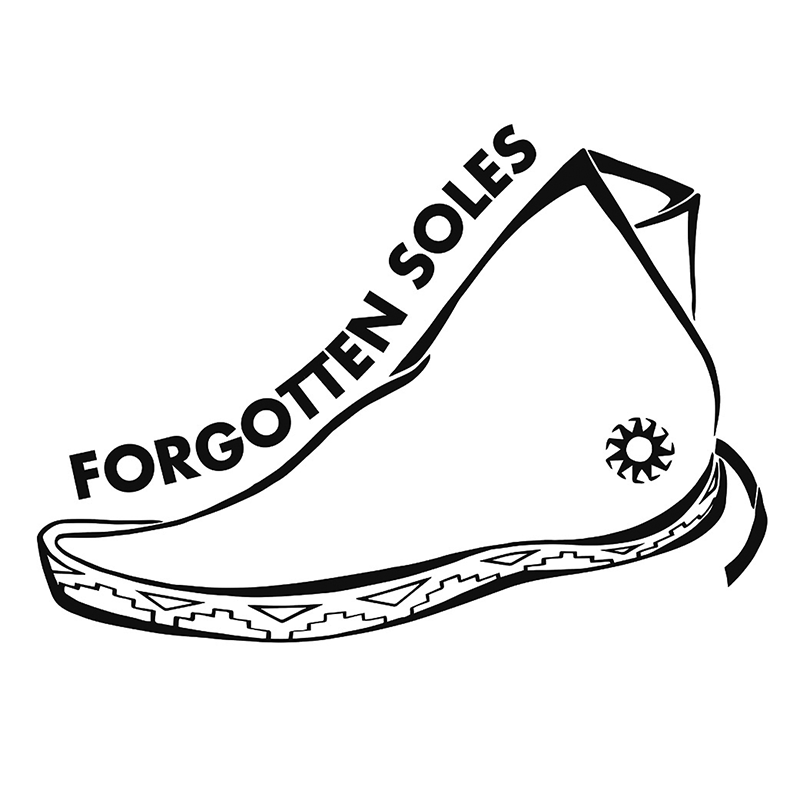
‘Forgotten Soles’ ties Long Walk history to today
By Stacy Thacker
Special to the Times
SAULT STE MARIE, Mich.
Four Diné artists are weaving history and art together as they share their interpretation of the Navajo wedding basket design and the history of the Long Walk. Siblings Miriam Diddy and Sarah Diddy are working with Garron Yepa and his wife, Winoka Yepa, on an art piece for New Mexico Arts Temporary Installations Made for the Environment series that will be on display from June 30 to Aug. 31 at the Bosque Redondo Memorial in Fort Sumner.
The memorial is a historic site dedicated to the history of the Long Walk. The series, also known as TIME, started years ago and encourages artists to create temporary and environmentally friendly art that engages the public and is interactive.

Courtesy photo
Forgotten Soles is an art installation dedicated to the history of the Long Walk and will be a temporary art display at the Bosque Redondo Memorial in Fort Sumner starting in June.
The goal, according to the TIME website, is to create spontaneous and immediate art installations that can be removed without leaving any trace. Miriam Diddy said their interpretation, titled “Forgotten Soles,” shows the journey of life through the basket design in correlation with the Long Walk and those who lost their lives on the way to Fort Sumner. “It’s critical for telling our story in our own way,” Miriam Diddy said.
For Winoka Yepa, the installation is an important way for her to share history that many people aren’t talking about. “Myself, as a Diné educator, I know how much the Long Walk and the history of this is often not told and is considered taboo,” she said. “Not many younger people know of this story and of what our Diné people went through.”
She recalls telling her nali about the project and being told that it was something she shouldn’t do and that Navajos aren’t supposed to go back and they aren’t supposed to think about things that happened in the past. “But you know, a lot of things that have happed in the past are really affecting us in the present,” Winoka Yepa said.
She hopes the installation is an educational tool. “None of us had collaborated like this before but I know we all have creative minds and wanted to express our respect for our ancestors who were forced through such a difficult process of the relocation,” Garron Yepa said.
The four-member team is creating a half wedding basket design by weaving together donated athletic shoes. The shoes represent the miles and miles walked on the way to Fort Sumner and the donation process was also a way to safely get the public involved in the art installation.
“We felt that allowing people to interact by donating their shoes was a good way to reduce the risk and encourage people to want to see the installation when it’s complete and find their shoes,” Garron Yepa said, adding that shoes tell a powerful story.
The installation, he said, is a way to reflect on the miles all these shoes have walked and the different personalities and age groups of people who wore them. The team put donation boxes at local businesses in Santa Fe and Albuquerque.
The goal was to have donation boxes set up in Native American communities but because of the different lockdowns and the pandemic, they decided against it. “We’re very cognizant of not wanting to put our people in jeopardy for the sake of this installation but that was a strong want in the beginning, to collect from our communities,” Garron Yepa said.
But shoes aren’t just coming in from communities in New Mexico, Miriam Diddy said the team has also received out of state donations as well, from people who are excited to be a part of the installation.
“Forgotten Soles” will be one of four installations at the memorial. The other three installations are being worked on by different artists. “Each of the installations are supposed to incorporate histories and stories about the Long Walk,” Garron Yepa said. “I think it’s a good way to raise awareness that this type of center exists and just let folks, like myself, who weren’t familiar, know that there is a center there that does speak to the Long Walk and its historic significance.”
Miriam Diddy said they will be doing a virtual tour of the installation when it’s done with behind-the-scenes content of the shoe collection and the weaving process. The team wants to make sure people still have access to the art piece even if they can’t make the trip to Fort Sumner and want to safely view it from home.
Garron Yepa said they’ve been asked why they aren’t using moccasins in their installation, but the team agreed that the number of moccasins they’d need would be hard to come by and they didn’t want to leave them exposed for long periods of time. When the installation is done, the team will disassemble the shoes and donate them to Nike’s recycle program where the shoes will be repurposed.
The installation requires up to 430 shoes and the team has over 100 pairs. If they can’t meet the amount needed, they have backup material they’ll use to fill in spaces where shoes would have gone. So far, the team has put in over 100 hours on the project and expect to put in more as they weave the project together. “I think we did a really good job of expressing how strong our people are,” Garren Yepa said.
Information: Forgotten Soles can be found on Instagram or on their website at https://forgottensoles.squarespace.com.







 Highway 264,
Highway 264, I-40, WB @ Winslow
I-40, WB @ Winslow